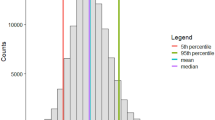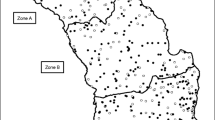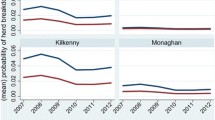Abstract
The European Badger (Meles meles) has been implicated in the epidemiology of bovine tuberculosis in cattle populations in the Republic of Ireland. Badger populations have been subject to a culling regime in areas with chronic histories of bTB cattle herd breakdowns. Removal data from 2004 to 2010 were used to model the impact of culling on populations in areas under capture. Additionally, changes in field signs of badger activity were used as an index of abundance to support, or otherwise, the outcomes of the removal models. Significant reductions in standardised badger captures over time were found across three large study areas (total area, 1,355 km2). Assuming that all inactive setts were vacant, an overall linear trend model suggested that badger captures had decreased by 78 % for setts with 6 years of repeated capturing operations. Given the uncertainty associated with the relationship between sett activity and badger presence, we repeated the linear modelling using two ‘what if’ scenarios. Assuming that individual badgers were missed on 10 % or 20 % of occasions at inactive setts, the estimated decline over 6 years is lowered to 71 % or 64 %, respectively. The decline profile consisted of a steep initial decrease in captures within the first 2 years, followed by a more gradual decrease thereafter. The number of active openings at setts (burrows) declined significantly in all three areas; but the magnitude of this decline varied significantly amongst study areas (41–82 %). There was a significant increase in the probability of setts becoming dormant with time. The removal programme was more intense (mean, 0.45 badgers culled km−2 year−1) than previous experimental badger removals in Ireland but some captures may be attributed to immigrant badgers as no attempt was made to limit inward dispersal from areas not under management. Results from this study suggest that significant reductions in badger density occurred in the areas where management had taken place. Since other non-culled badger populations in Northern Ireland and Britain exhibited stable population trends, we attribute the reduction in relative abundance to the culling regime. Further studies of the dynamics of this reduction are required to quantify how it is counteracted by immigration from populations outside of culled areas.



Similar content being viewed by others
References
Anon (1996) Badger manual. Department of Agriculture, Food and Forestry, Dublin
Baker PJ, Harris S (2006) Does culling reduce fox (Vulpes vulpes) density in commercial forests in Wales, UK? Euro J Wildl Res 52:99–108
Bonesi L, Macdonald DW (2004) Evaluation of sign surveys as a way to estimate the relative abundance of American mink (Mustela vison). J Zool 262:65–72
Bourne J, Donnelly C, Cox D, Gettinby G, McInerney J et al (2008) Badgers and cattle TB: the final report of the independent scientific group on Cattle TB. The Stationery Office, UK
Byrne AW, Sleeman DP, O’Keeffe J, Davenport J (2012a) The ecology of the European badger (Meles meles) in Ireland—a review. Biol Environ—Proc R Irish Acad 112B:105–132
Byrne AW, O’Keeffe J, Sleeman DP, Davenport J, Martin SW (2012b) Factors affecting European badger (Meles meles) capture numbers in one county in Ireland. Prev Vet Med (in press)
Corner LAL, Clegg TA, More SJ, Williams DH, O’Boyle I et al (2008) The effect of varying levels of population control on the prevalence of tuberculosis in badgers in Ireland. Res Vet Sci 85:238–249
Defra (2011) The long term intensive ecological and epidemiological investigation of a badger population naturally infected with M. Bovis—SE3032. randd.defra.gov.uk/Document.aspx?Document = 9871_textfor2011SE3032finalreport.doc. Accessed 4th June 2012
Deutscher Jagdschutz-Verband (2012) Deutscher Jagdschutzverband, Handbuch 2012. http://medienjagd.test.newsroom.de/201011_strecke_dachse2.pdf. Accessed 10th April 2012
Dohoo IR, Martin SW, Stryhn H (2010) Veterinary epidemiologic research, 2nd edn. VER Inc, Canada
Eves J (1999) Impact of badger removal on bovine tuberculosis in east County Offaly. Irish Vet J 52:199–204
Fealy RM, Green S, Loftus M, Meehan R, Radford T et al (2009) Teagasc indicative habitat maps by county. In: Fealy RM, Green S (eds) Teagasc EPA soil and subsoils mapping project-final report. Teagasc, Dublin
Feore SM (1994) The distribution and abundance of the badger Meles meles L. Queens University Belfast, Northern Ireland
Gortázar C, Delahay RJ, McDonald RA, Boadella M, Wilson GJ, Gavier-Widen D, Acevedo P (2011) The status of tuberculosis in European wild mammals. Mamm Rev. doi:10.1111/j.1365-2907.2011.00191.x
Griffin JM, Williams DH, Kelly GE, Clegg TA, O’Boyle I et al (2005) The impact of badger removal on the control of tuberculosis in cattle herds in Ireland. Prev Vet Med 67:237–266
Halls PJ, Bulling M, White PCL, Garland L, Harris S (2001) Dirichlet neighbours: revisiting Dirichlet tessellation for neighbourhood analysis. Comp Environ Urb Syst 25:105–117
Hammond RF, McGrath G (1998) The use of geographical information system (GIS) derived tessellations to relate badger territory to distribution patterns of soils and land use environmental habitat variables within the East Offaly badger research area. ERAD Tuberculosis Investigation Unit, University College Dublin, Selected Papers 1997. pp. 14–25
Hammond RF, McGrath G, Martin SW (2001) Irish soil and land-use classifications as predictors of numbers of badgers and badger setts. Prev Vet Med 51:137–148
Hardin JW, Hilbe JM (2003) Generalized estimating equations. Chapman & Hall/CRC, London
Healy R (2010) TB Programme 2011: Annex 1. Report to the European Commission. http://www.agriculture.gov.ie/media/migration/animalhealthwelfare/diseasecontrols/tuberculosistbandbrucellosis/diseaseeradicationpolicy/2011TBProgramme130111.pdf . Accessed 10th April 2012
Hilbe JM (2011) Negative binomial regression. Cambridge University Press, UK
Holmala K, Kauhala K (2006) Ecology of wildlife rabies in Europe. Mamm Rev 36:17–36
Horton NJ, Bebchuk JD, Jones CL, Lipsitz SR, Catalano PJ et al (1999) Goodness-of-fit for GEE: an example with mental health service utilization. Stat Med 18:213–222
Kauhala K (1995) Changes in distribution of the European badger Meles meles in Finland during the rapid colonization of the raccoon dog. Ann Zool Fenn 32:183–191
Kauhala K, Auttila M (2010) Habitat preferences of the native badger and the invasive raccoon dog in southern Finland. Act Theriol 55:231–240
Kauhala K, Holmala K (2011) Landscape features, home-range size and density of northern badgers (Meles meles). Ann Zool Fenn 48:221–232
Kelly GE, Condon J, More SJ, Dolan L, Higgins I et al (2008) A long-term observational study of the impact of badger removal on herd restrictions due to bovine TB in the Irish midlands during 1989–2004. Epidemiol Inf 136:1362–1373
Keuling O, Greiser G, Grauer A, Strauss E, Bartel-Steinbach M et al (2010) The German wildlife information system (WILD): population densities and den use of red foxes (Vulpes vulpes) and badgers (Meles meles) during 2003–2007 in Germany. Euro J Wildl Res 57:95–105
Kranz A, Tikhonov A, Conroy J, Cavallini P, Herrero J, Stubbe M, Maran T, Fernandes M, Abramov A, Wozencraft C (2008) Meles meles. In: IUCN 2011. IUCN Red List of Threatened Species. Version 2011.2. www.iucnredlist.org. Downloaded on 09 January 2012
Liang KY, Zeger SL (1986) Longitudinal data analysis using generalized linear models. Biometrica 73:13–22
McCullagh P, Nelder JA (1989) Generalized linear models. Chapman & Hall/CRC, London
More SJ, Good M (2006) The tuberculosis eradication programme in Ireland: a review of scientific and policy advances since 1988. Vet Microbiol 112:239–251
Muñoz-Igualada J, Shivik JA, Domínguez FG, Lara J, González LM (2008) Evaluation of cage-traps and cable restraint devices to capture red foxes in Spain. J Wildl Manage 72:830–836
Murphy D, O’Keeffe JJ, Martin SW, Gormley E, Corner LAL (2009) An assessment of injury to European badgers (Meles meles) due to capture in stopped restraints. J Wildl Dis 45:481–490
O’Keeffe JJ (2006) Description of a medium term national strategy toward eradication of Tuberculosis in cattle in Ireland. In: Proceedings of the 11th Symposium of the International Society of Veterinary Epidemiology and Economics, Cairns, Australia. p. 502. http://www.sciquest.org.nz/node/64117. Accessed on 10th April 2012
O’Connor CM, Haydon DT, Kao RR (2012) An ecological and comparative perspective on the control of bovine tuberculosis in Great Britain and the Republic of Ireland. Prev Vet Med 104:185–197
O’Mairtin D, Williams DH, Griffin JM, Dolan LA, Eves JA (1998) The effect of a badger removal programme on the incidence of tuberculosis in an Irish cattle population. Prev Vet Med 34:47–56
Pan W (2001) Akaike’s information criterion in generalized estimating equations. Biometrics 57:120–125
Reid N, Etherington TR, Wilson G, McDonald RA, Montgomery WI (2008) Badger survey of Northern Ireland 2007/08. Quercus and Central Science Laboratory for the Department of Agriculture & Rural Development (DARD), Northern Ireland
Reid N, Etherington TR, Wilson GJ, Montgomery WI, McDonald RA (2011) Monitoring and population estimation of the European badger (Meles meles) in Northern Ireland. Wildl Biol 18(1):46–57
Roper T (2010) Badger. Harpercollins Pub Ltd., UK
Sadlier L, Montgomery WI (2004) The impact of sett disturbance on badger Meles meles numbers; when does protective legislation work? Biol Cons 119:455–462
Sadlier LMJ, Webbon CC, Baker PJ, Harris S (2004) Monitoring foxes (Vulpes vulpes) and badgers (Meles meles): are field signs the answer? Mamm Rev 34:75–98
Sheridan M (2011) Progress in tuberculosis eradication in Ireland. Vet Microbiol 151:160–169
Sleeman DP, Davenport J, More SJ, Clegg TA, Collins JD et al (2009) How many Eurasian badgers Meles meles L. are there in the Republic of Ireland? Euro J Wildl Res 55:333–344
Szmaragd C, Green L, Medley G, Mitchell A, Browne W. (2010) Estimating badger numbers from badger survey signs, with applications to bovine TB prediction. Soc Vet Epidemiol Prev Med (SVEPM): Proc, Nantes, France
Tuyttens FAM, Macdonald DW, Delahay R, Rogers LM, Mallinson PJ et al (1999) Differences in trappability of European badgers Meles meles in three populations in England. J Appl Ecol 36:1051–1062
Tuyttens FAM, Long B, Fawcett T, Skinner A, Brown JA, Cheeseman CL, Roddam AW, Macdonald DW (2001) Estimating group size and population density of Eurasian badgers Meles meles by quantifying latrine use. J Appl Ecol 38:1114–1121
Wilson GJ, Delahay RJ, de Leeuw ANS, Spyvee PD, Handoll D (2003) Quantification of badger (Meles meles) sett activity as a method of predicting badger numbers. J Zool 259:49–56
Wilson GJ, Carter SP, Delahay RJ (2011) Advances and prospects for management of TB transmission between badgers and cattle. Vet Microbiol 151:43–50
Woodroffe R, Gilks P, Johnston WT, Le Fevre AM, Cox DR et al (2008) Effects of culling on badger abundance: implications for tuberculosis control. J Zool 274:28–37
Acknowledgments
AWB was supported by a Walsh Fellowship from Teagasc—The Irish Agriculture and Food Development Authority (www.teagasc.ie). All data were generated during licensed bovine TB control activities funded through the Department of Agriculture, Fisheries and Food (www.agriculture.gov.ie) as part of the medium term national strategy toward eradication of bovine TB. The authors wish to thank Stuart Green (Teagasc), Dr. Liam Lysaght and the staff of the National Biodiversity Data Centre for their support during the writing of this paper. Gratitude is extended to all the field staff in Longford, Monaghan and South Tipperary and administrative staff within the Wildlife Unit of the Department of Agriculture, which contributed to data collection during this project. We also wish to thank all land owners for cooperating during the fieldwork of this study. The manuscript was greatly improved by comments from two anonymous reviewers.
Competing interests
The authors have declared that no competing interests exist.
Author information
Authors and Affiliations
Corresponding author
Additional information
Communicated by C. Gortázar
Rights and permissions
About this article
Cite this article
Byrne, A.W., O’Keeffe, J., Sleeman, D.P. et al. Impact of culling on relative abundance of the European badger (Meles meles) in Ireland. Eur J Wildl Res 59, 25–37 (2013). https://doi.org/10.1007/s10344-012-0643-1
Received:
Revised:
Accepted:
Published:
Issue Date:
DOI: https://doi.org/10.1007/s10344-012-0643-1




